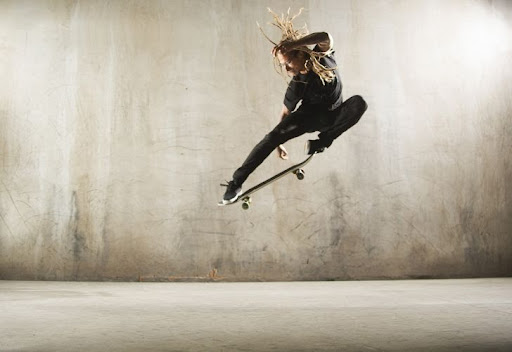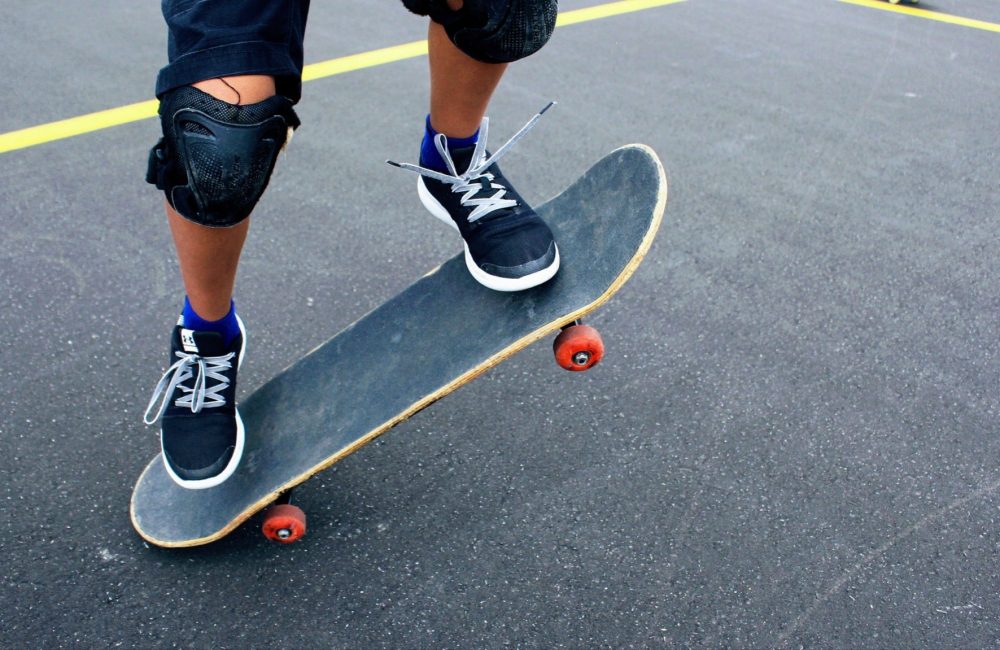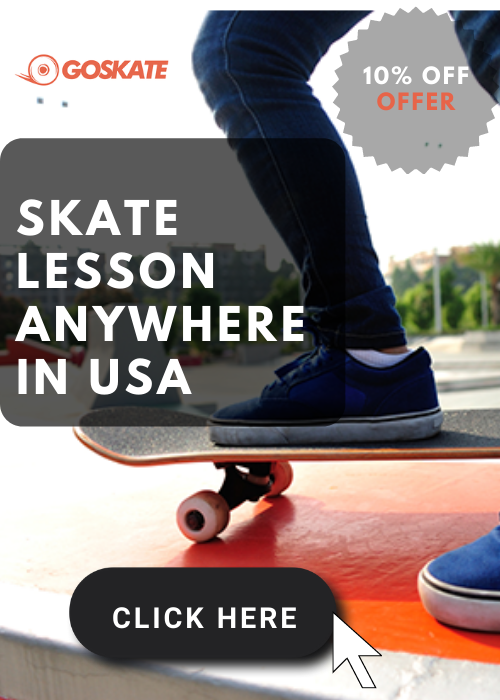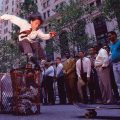Learning how to ollie is practically a right of passage to become a skateboarder. While the ollie is the first trick in skateboarding most skaters strive to learn, it can also be one of the hardest tricks to learn on a skateboard without proper instruction.
In this article, we’ll be breaking down “How To Ollie” in a detailed tutorial, explaining step by step the proper foot-placement and mechanics to not only ollie but ollie higher.
In addition, in this article we’ll also be covering:
- Why the Ollie is the Foundation to Skateboarding
- History of the Ollie
- How to Ollie Step by Step
- Tips on How To Ollie Higher
- How to Ollie Onto an Obstacle
- Best Ollies in Skateboarding
- Bonus* How Learning how to Ollie can Help you Kickflip
Why the Ollie is the Foundation of Skateboarding

Why is the ollie so important to skateboarding? Well for starters, it’s the first trick most people see that blows their mind and attracts them to skateboarding. How the heck did you do that? How do you make the board come up like that and defy gravity? WOW!
Many times when a pro skater talks about how they fell in love with skateboarding, it’s after they saw their brother or someone in the neighborhood pop an ollie.
However, the ollie is most important because it makes up the foundation of all skateboard tricks. Even Tony Hawk’s 900 started his rotation off with an ollie and the same for Yuto Horigome’s runs during The Olympics.
Historically as well, the ollie allowed for skaters to be able to skate into different styles of skating.
Vertical skating, street skating, park skating, and even flat ground all begin with the ollie. Essentially, if it wasn’t for the ollie, skaters wouldn’t be getting air. So literally, the ollie took skateboarding to new heights.
In conclusion, you need to ollie before you can do a kickflip or grind down a rail or launch off a ramp. It’s why every skater wants to learn how to ollie and why we have learning how to ollie as a focal part of our skate lessons.
Because simply put, if you want to get good at skateboarding, you must perfect the ollie.
At GOSKATE we offer the most comprehensive teaching instructions on How To Ollie both online and with our instructors. In addition to this article, you can contact us today to find an instructor to teach you how to ollie and achieve your skateboarding goals!
How To Ollie – GOSKATE Step by Step Tutorial
We’re going to break it down both through bullet points and a video for you to learn how to ollie. By the end of our instruction, you’ll have everything you’ll need to know about the most important trick in skateboarding.

(Tip 1)
Find an appropriate space to practice learning how to ollie: this should be flat ground in an empty parking lot, your driveway or empty skatepark early in the morning. Watch out for cracks and debris!
(Tip 2)
Practice ‘Standing Still’: as in, do not attempt to do a rolling ollie but one in place. Stand on your board and practice centering your balance. This can all be mastered by GOSKATE certified instructors in four or less lessons through our fundamentals of skateboarding philosophy.

(Step 1)
Proper Foot Positioning: Okay, down to the nitty gritty. The proper foot position is broken up into the front foot and the back foot.
Front Foot: Place the front foot in the middle of your skateboard and well below your front wheels and bolts. This might feel uncomfortable at first, but that’s okay. That’s a sign of progressing.
Generally, the lower your front foot the better for learning how to ollie. This will help promote the slide up to your nose to create the leveling out of your board but always start with where you feel comfortable and adjust from there.
Back Foot: Your back foot is arguably the more important foot as it is usually the foot that causes the most obstacles in terms of learning how to ollie. This is your “popping” foot. You’ll need to have your toes and ball of your foot on the very edge of your board.
Essentially, as little of your back foot as possible to avoid muting your pop. You might feel like a cat climbing a fence at first but don’t worry, every skater was once in your shoes.

(Step 2)
Crouch Down: Crouching down is what is going to allow you the vertical leverage to jump high enough to produce an ollie. Some people will crouch lower than others, but it is generally understood to do whatever is necessary to jump as high as possible. When you crouch, maintain a center of balance. This is key.

(Step 3)
Pop Your Tail: This is usually the most counter intuitive step in the process of learning how to ollie. Practice first by smacking your tail on the ground to a halt with your back foot, so your board is at a 45° angle and resting on the back wheels.
Remember, use your toes and the least amount of the ball of your foot as possible. This will avoid muting your pop, as the popping of your board will need to be done as fast as possible to simultaneously produce the mechanics necessary to catch air.

(Step 4)
Slide Your Front Foot Up to the Nose: It’s time to become a skateboarder. Sliding your front foot up from the middle of your board to your nose for the first time seems impossible. But we’ve seen countless students regardless of age eventually master this technique. You’ll want to slide your front foot up to the front of your board, pass the front bolts and onto the cusp of your nose.
You have to do this at the same time, right after you pop your tail to bring the board up from the ground. Your front trucks will already be off the ground, the middle of the board will be free from the weight of your front foot, and the nose of the board will launch you to landing your first ollie.

(Step 5)
Level Out and Land: We felt we had to include this step for comprehensive reasons, but the leveling out should be produced from the front foot sliding up and a successful popping of your tail. After practicing the steps here, you’ll get more and more comfortable maintaining your balance through all the steps so you’ll land with all four wheels on the ground and roll away.
Recap: Practice in a safe space without cars, pedestrians or other skaters zipping by and standing still. Get your foot placement in the proper positions, crouch down before popping your tail; quickly slide your front foot up to your nose leveling out your board and lifting your back wheels off the ground.
Congratulations. You just did your first ollie!
But Wait, There’s More!
We’ve got another section on tips for increasing the height of your ollie and even exercises to improve your form! Also, as your number one trusted source for everything skateboarding, we’re going to delve into the history of the ollie and some of the most legendary ollie ever landed!
The History of the Ollie

To be completely honest, due to the ambiguous nature of skateboarding’s birth, the exact who and where of the first ollie is somewhat debatable. That being said, the skateboard world has agreed, Alan “Ollie” Gelfand invented [sic] the ollie in the 1970s.
It is probably more accurate to say Alan “Ollie” Gelfand perfected the ollie by 1978 and made it clear to the skateboarding world the trick would become fundamental to the future of skateboard tricks.
But if skateboarding was born in the 50s and 60s, why did it take so long for the ollie to be invented?
The board shapes of the first skateboards often had very small noses and flat tails with no grip tape. That means you could not pop the tail of the board and gain traction on the grip tape to perform the back foot and front foot maneuvers to produce an ollie. That’s where a certain someone comes in.
You probably guessed it, we also can’t talk about the ollie without mentioning Rodney Mullen.
While Rodney Mullen is famous for inventing skateboarding tricks left and right, tearing up whatever skatepark or contest he was in, the board shapes and designs sent his innovation in different directions – handstands, finger flips, tailspins and other flat ground tricks – before he eventually found the ollie.

However, once the ollie was in the forefront of skate progression, Rodney Mullen took it and ran away (or skated away rather) with it.
Rodney would take what he learned with the ollie and invent nearly every flat ground flip trick we see in contemporary skating today.
Some tricks Rodney Mullen invented thanks to the ollie are: Kickflips, backside flips, heelflips, 360 flips, double flips, impossibles, dark slides and nearly an infinite list of freestyle tricks and flatground tricks.
It should also be mentioned, many media outlets will mention Rodney Mullen invented the flat ground ollie or the ollie altogether.
Tips on How To Ollie Higher

Once you are able to get all pop your tail, slide your foot up, level out and get all four wheels off the ground in a successful ollie, you’re ready for our tips on how to ollie higher.
While learning how to ollie at all is the most important, you’ll find in order to get good at skateboarding, you have to constantly refine and work on perfecting tricks. The ollie is no different.
So here are some tips for learning higher ollies.
Crouch lower: While at first crouching lower might cause you to lose your balance easier, eventually it will help you jump higher and even increase your style.

Suck your knees up to your chest: Some of the best skaters in the world will accidentally knee themselves in the face while ollieing over a high obstacle. Always suck your knees up as high as you can to produce the highest ollie possible.
Ollie in a crack: This is a lifelong proven trick to helping you stand still while learning how to Ollie. It’s something we implement when our instructors are teaching kids and adults how to ollie for the first time.
Hold onto a railing: Holding onto the railing is similar to being in a crack while learning how to ollie. The difference is, holding onto a railing will allow you to take the weight off your legs and practice sucking your knees up or popping your board without the consequences of your full weight. This is also a great way to learn kickflips when you’re ready.
Film your progress: Filming your progress is a great way to see what you’re doing right and what you’re doing wrong. Maybe you’ll notice your front foot isn’t reaching the cusp of your nose or that your back is indeed muting your pop. You can also post your video onto social media and ask others for tips. You’ll start landing higher ollies in no time!
Work on jumping higher both on and off a skateboard: this might sound a little confusing, but practicing your vertical jump both on and off a skateboard will help you ollie higher. Remember it’s all about sucking up your knees and having strong muscles.

Skate with a GOSKATE Instructor: Our instructors are trained to help you master the foundation of skateboarding and learn how to ollie within a few weeks. We’ve taught skaters of all ages and skill level and have seen great results – especially in young kids. While a video or an article is a great resource, nothing is better than another skater who’s mastered the art of the Ollie.
How to Ollie On an Obstacle

Every skateboarder will tell you: learning how to ollie onto a curb changed their life.
Picture this – you’re skating through a neighborhood and you no longer have to get off your board to cross the street because a curb or pesky crack is in your way.
The result is true freedom of movement a.k.a. one of the best feelings about skateboarding.
Learning to ollie while moving and specifically learning to ollie on an obstacle is the first step in learning the advanced skateboard tricks like grinding down rails or skating ledges.
Here are some tips and steps you’ll need to master to learn how to ollie on an obstacle.

Master the rolling ollie: While you can learn how to ollie on an obstacle while standing still, you won’t get very far once you’re on the obstacle. Practice the rolling ollie by placing a watering hose in your driveway.
Practice ollieing onto grass curbs: When it comes to learning skateboarding tricks, grass is your best friend. Just find a curb with grass next to it, roll head on and practice ollieing onto the grass. This will help mentally and physically prepare you to ollie on an obstacle and eventually ride away.

Approach at an angle frontside: approaching at an angle frontside will be easier than approaching head on since you’ll have less of your board to learn onto the obstacle. Frontside is also easier than the back side for visibility and opening your center of gravity to the obstacle. The majority of trick tips in the future will include the first step of “approach at an angle.”
Lead with your front truck: It’s your front truck and back truck not your wheels you’ll need to think about. Imagining it this way, you want to approach the red curb at an angle, ollie while moving and land your front and back truck onto the curb. Wow! You just did your first 5050 grind.
How to Practice and Exercise to Improve Your Ollie
Front Hand Position: Wait, what? What do your hands have to do with learning how to ollie? We’ll for starters, your balance. Being mindful of having your front hand hang loosely over your nose will help you maintain your balance and center of gravity. It will also naturally keep your shoulders open for your front foot to slide up and maintain a cohesive full body movement. Which brings us to our next practice exercise.
Imagine an X on the Nose of your Board: Visualization is key in skateboarding. It’s where the tricks you haven’t learned first get their wings. The ollie being your first palpable skate trick, of course includes visualization. Imagine an X at the foot of your nose, right at the concave. So when you slide up your front foot, imagine it hitting this mark and curling to level the board out. Imagine the X and your front hand also being on the same plane. This will overall promote balance and the oneness needed for correct timing of the ollie.

‘Feel’ the Timing: A lot of skateboarding is instinctual. You have to feel as much as visualize as you go about learning a trick. So the timing is a combination of understanding all the key points in this article and slowly but surely identifying the timing and rhythm where they all meet in unison to create the ollie. This is why the ollie is such a beautiful trick and fulfilling feeling. It’s like the sound of a perfect swish and bowling a strike all in one.
Best Ollies in Skateboarding
While competition skateboarding can crown a winner or a first place, there really is ‘no best’ ollie in skateboarding. However, there are some skaters out there who are celebrated for their ollies and set the standards both physically and stylistically for what are the best ollies.
The current world record for highest flatground ollie was set by Aldrin Garcia during the Maloof High Ollie Challenge, back on February 15th, 2011. Considering how much skateboarding has changed since then, it really is amazing the record has not been broken. But then you hear the height… 45 inches or 114.3 centimeters! Wow!
Rumor has it that Aldrin skated a specially crafted light board and hollow trucks, which did spark some controversy over the record. Even so, no one has been able to break it even with their own especially crafted boards.

A new world record is not being recognized by Guinness Book of World Records, when Jake Hayes and Xavier Alford tied for 45.5 inches during an ETN live event. Skateboarding will always remain somewhat unofficial in its subculture nature, alongside the simple fact the majority of skateboarders are apathetic to the record; especially in terms of comparing the praise they have for other skaters on this list.
Jeremy Wray: is largely regarded as the king of the ollie, as his skate career produced some of the gnarliest feats of the ollie ever seen. His most famous ollie is his water tank ollie, a death defying ollie between two colossal water tanks no one has attempted since.
Aaron “Jaws” Homoki: When it comes to the ollie being capable of pushing skateboarding to new heights, no statement rings truer in this respect than Aaron “Jaws” Homoki. If superman could leap tall buildings in a single feat, Jaws could ollie off them with a single pop. Jaws once ollied off something so high, when he landed his knee hit his face breaking his jaw.
Andrew Brophy: While most people are stoked to be ollieing down 7-stairs, Andrew Brophy ollies up (yes up) seven stairs. While his height is definitely a factor, no one can deny the Australian Andrew Brophy has one of the highest ollies ever seen.

John Cardiel: John Cardiel is included on this list as one of the most legendary skateboarders of all time. Even as the industry favored street skaters in his time, John never lost connection with his park and vert roots, airing over quarter pipes like a dove from the heavens. His ollie style reminds us why skateboarding is as much an artform as a sport and to this day is remembered and interviewed for ollies he’s landed throughout his illustrious career.

BONUS* How Learning How To Ollie Can Help you Kickflip
Learning how to ollie is necessary in learning how to kickflip. Here’s a few tips and steps on how learning how to ollie can help you learn how to kickflip.
Once you’ve mastered the foundation of skateboarding and are producing an ollie on a regular basis, you’re ready to start learning how to kickflip.
Grab a railing: Remember this helpful tip from above? Grabbing a railing will help lessen the risk and produce a weightlessness suitable for trying new things.

It’s in the toes: While your back foot is learning how to ollie already promoted using mostly your toes to promote a healthy pop, your front foot will need to be focusing on toe movement to produce the ‘flick’ needed for a kickflip.
Flick off your nose: While an ollie catches the cusps of your nose to produce the leverage needed to level out your board, a kickflip goes a step farther by pushing even more to flick off the side of the nose. This is what causes the board to rate or to flip.

Back foot catch: Once you practiced flipping the board, eventually the board will flip up and be caught by the back foot. While you’re first practicing you might have a tendency to land with one foot off the board. Be careful, this can lead to bad habits of not committing.
Commit with the front foot: Even if you’re learning on the grass or holding onto a railing, you need to get in the habit of committing to land on the board with your front foot after it flips. If you’re only getting one foot on the board after flipping, make sure it’s the front!

Want To Learn More About Skateboarding?
Contact us to help foster you or your loved one’s new found passion for skateboarding with our GOSKATE classes!
Get The Latest Skateboard News
Improve Your Skating
If you sign up for our skate lessons, our certified instructors will be there with open arms to catch you if you fall.
Help you or your loved one gain self confidence and maintain an active healthy lifestyle by contacting GOSKATE.














